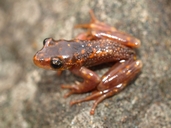|
Boophis williamsi (Guibé, 1974)
Subgenus: Boophis | family: Mantellidae subfamily: Boophinae genus: Boophis |
 © 2014 Devin Edmonds (1 of 8) |
|
|
|
Description Similar species: The species has a rather unique appearance and a very restricted distribution and habitat, and is therefore unlikely to be confused with other species. Distribution and Habitat Country distribution from AmphibiaWeb's database: Madagascar
Life History, Abundance, Activity, and Special Behaviors Calls: Unknown. It breeds in fast-flowing mountain streams (Vences and Nussbaum 2008). Trends and Threats Possible reasons for amphibian decline General habitat alteration and loss Comments
References
Glaw, F. and Vences, M. (1994). Amphibians and Reptiles of Madagascar. M. Vences and F. Glaw Verlags GbR., Köln. Glaw, F., and Vences, M. (2007). Field Guide to the Amphibians and Reptiles of Madagascar. Third Edition. Vences and Glaw Verlag, Köln. Vences, M. and Nussbaum, R. (2008). Boophis williamsi. In: IUCN 2008. 2008 IUCN Red List of Threatened Species. www.iucnredlist.org. Downloaded on 07 April 2009. Originally submitted by: Miguel Vences and Frank Glaw (first posted 2000-10-30) Edited by: Henry Zhu (2009-05-05) Species Account Citation: AmphibiaWeb 2009 Boophis williamsi <https://amphibiaweb.org/species/4364> University of California, Berkeley, CA, USA. Accessed Jun 8, 2025.
Feedback or comments about this page.
Citation: AmphibiaWeb. 2025. <https://amphibiaweb.org> University of California, Berkeley, CA, USA. Accessed 8 Jun 2025. AmphibiaWeb's policy on data use. |




 Map of Life
Map of Life